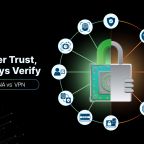Zero Trust Network Access (ZTNA): A CISO’s Guide to Secure Access
June 06, 2024
Overview
Zero Trust Network Access (ZTNA) is more than just another acronym in the cybersecurity landscape. It’s a transformative approach designed to address real-world security challenges that have long hindered our ability to protect digital assets effectively. As CISOs, we must navigate this evolving landscape with a keen understanding of the strategic and operational imperatives that ZTNA entails. This guide aims to provide my fellow CISOs with a comprehensive overview of ZTNA, offering actionable insights and practical recommendations to enhance our cybersecurity posture.
The Imperative for Zero Trust
In an era where cyber threats are increasingly sophisticated and pervasive, traditional perimeter-based security models have proven inadequate. Zero Trust is not merely a buzzword; it’s a fundamental shift in our approach to cybersecurity. At its core, Zero Trust operates on three essential principles:
- Identity and Context-Based Access: Access decisions are based on user identity, device health, and context rather than a user’s location within the network.
- Micro-Segmentation: This strategy involves breaking the network into smaller, isolated segments to limit an attacker’s lateral movement.
- Continuous Monitoring and Validation: Instead of one-time verification, access requests are continuously monitored and validated.
The Role of Zero Trust Network Access
Zero Trust Network Access (ZTNA) extends the principles of Zero Trust by creating identity- and context-based logical access boundaries around users, devices, and applications. This approach ensures that trust is continuously verified and never implicitly granted. Unlike traditional VPNs, which can be cumbersome and insecure, ZTNA provides a more secure, flexible, and scalable solution for our increasingly hybrid work environments.
Growing Interest and Implementation Challenges
The adoption of Zero Trust Network Access (ZTNA) is accelerating across both public and private sectors, driven by regulatory mandates and a heightened focus on cybersecurity. However, the path to Zero Trust maturity is fraught with challenges:
- Verification of Security Posture: Post-deployment verification remains a significant challenge due to the lack of reliable metrics.
- Integration Issues: Integrating disparate security products into a cohesive ZTNA framework can be complex and resource-intensive.
- Static Policies: Many ZTNA implementations rely on static signals, failing to adapt to the dynamic nature of modern cyber threats.
Strategic Planning for Zero Trust Network Access
To effectively implement Zero Trust Network Access (ZTNA), strategic planning is crucial. Consider the following assumptions and recommendations:
- Avoiding Stalled Deployments: By 2027, 70% of organizations may experience stalled ZTNA deployments without advancements in policy decision points (PDPs). Investing in technologies that enhance PDP capabilities is essential.
- Exclusion of Unmanaged Assets: By 2028, 76% of organizations will exclude unmanaged devices and non-virtualized environments to streamline ZTNA implementations and reduce complexity.
- Dynamic Access Controls: By 2027, 25% of organizations will adopt continuous, dynamic, risk-based access controls.
Practical Steps for ZTNA Implementation
To deploy Zero Trust Network Access (ZTNA) effectively, consider these practical steps:
- Phased Implementation: Begin with high-risk applications or technology-savvy pilot users. This phased approach maximizes ROI and minimizes operational disruptions.
- BYOD and Extended Workforce: Target BYOD and extended workforce use cases for remote access VPN replacement with clientless ZTNA and integrate agent-based ZTNA into a broader Secure Access Service Edge (SASE) architecture.
Vendor Selection Criteria for ZTNA
Selecting the right ZTNA vendor is critical. Focus on vendors that:
- Support a Wide Range of Security Needs: Ensure the vendor meets comprehensive security requirements for managed devices and offers a path to unified, dynamic access control policies.
- Offer Scalability and Flexibility: Choose vendors that support both agent-based and agentless approaches to cover all use cases effectively.
- Emphasize Granular Access Control: Implement ZTNA solutions that provide granular access control for all users and applications.
Ensure Trust Broker Redundancy: Ensure the trust broker system is redundant to avoid single points of failure and minimize latency issues.
How Thinfinity Can Help
At Thinfinity, we understand the complex challenges that CISOs face in today’s dynamic threat landscape. Our Zero Trust Network Access (ZTNA) solutions are designed to provide comprehensive, scalable, and secure access control that aligns seamlessly with modern security frameworks:
- Comprehensive Integration: Thinfinity ensures smooth integration across various platforms, overcoming the challenge of disjointed point products and ensuring a unified security posture.
- Dynamic Policy Enforcement: Our solutions facilitate the transition from static to dynamic access policies, leveraging real-time context-based signals to enhance security.
- Scalable Governance: Our governance framework drives measurable business benefits, aligning your security posture with organizational goals.
- Vendor-Neutral Compatibility: We support environments with vendor-neutral policy decision points (PDPs), enhancing interoperability and flexibility, which is crucial for diverse and complex IT ecosystems.
The Zero Trust Network Access (ZTNA) market is expanding rapidly, driven by the need for secure, flexible connectivity for hybrid workforces. With significant year-over-year growth, ZTNA is becoming a cornerstone of modern cybersecurity strategies. Thinfinity’s comprehensive ZTNA solution is designed to help organizations navigate this growth, providing secure, scalable, and dynamic access control that aligns with Secure Access Service Edge (SASE) strategies.
Conclusion
Zero Trust Network Access (ZTNA) represents a pivotal shift in how we approach cybersecurity. By implementing ZTNA, we can enhance our security posture, reduce risk, and adapt to the ever-evolving threat landscape. Thinfinity is committed to supporting your journey towards a mature, resilient Zero Trust architecture, ensuring your digital assets are secure against emerging threats. Embrace the future of cybersecurity with Thinfinity’s robust ZTNA solutions and stay ahead in your Zero Trust journey.
Optimize Your Cybersecurity with Thinfinity
Interested in implementing Thinfinity’s ZTNA solutions in your organization? Get a customized quote based on your unique requirements. Our team will provide a detailed breakdown to help you understand the costs and benefits.
Experience Thinfinity’s ZTNA Solution Firsthand
Ready to see how Thinfinity’s Zero Trust Network Access (ZTNA) can transform your organization’s security? Schedule a personalized demo to explore our robust and scalable solutions. Our experts will guide you through the features and benefits tailored to your specific needs.




